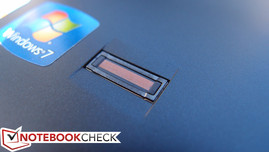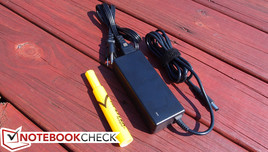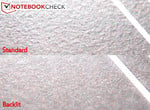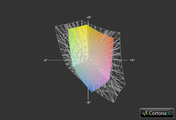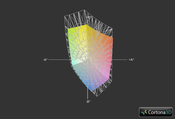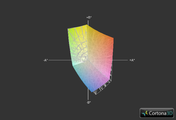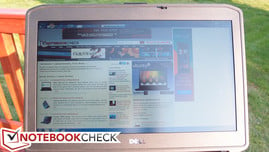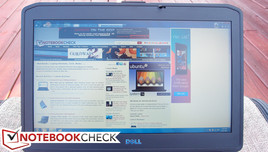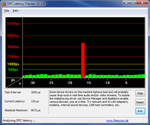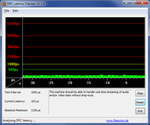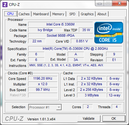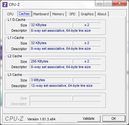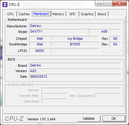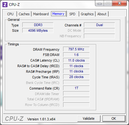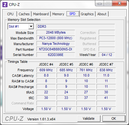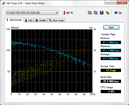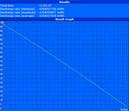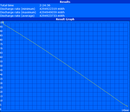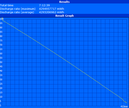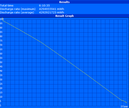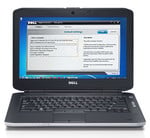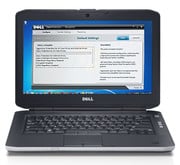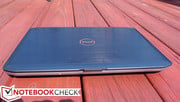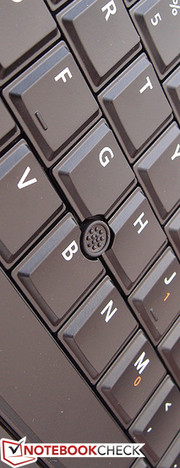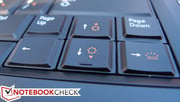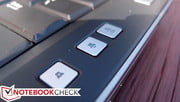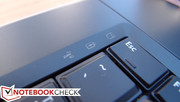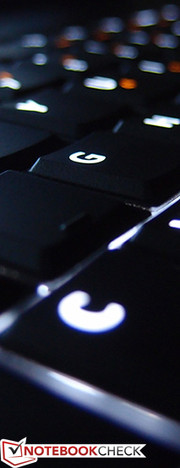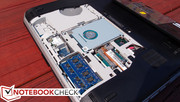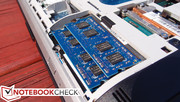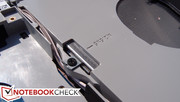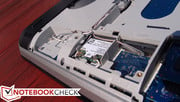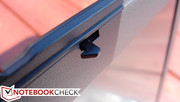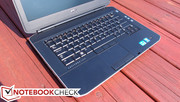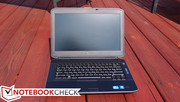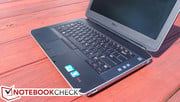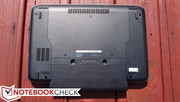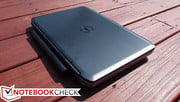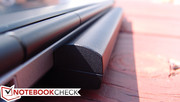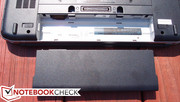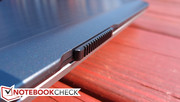戴尔 Latitude E5430 笔记本

Dell’s Latitude models always put practicality first. With a perpetually no-nonsense design and solidity that rivals even the fiercest opponents, it’s one of the first places many businesspeople look when considering a primary machine. And rightfully so; not many notebooks exist which hail from such a glistening lineage of enterprise-grade dependability.
Two weeks ago, we brought you our full review of the newest member of the Latitude E5XXX family, the E5530. In it, we praised its impressive performance, stable construction, great battery life, and largely unmatched input devices. We were pleased by the inclusion of two USB 3.0 ports, an upgrade which the E5430 also boasts over its predecessor (the E5420). Meanwhile, we had our reservations about the E5530’s hefty weight, noise level, and subpar fit and finish. The distinction between the Latitude 6XXX series and the lower-grade 5XXX series is certainly evident in a side-by-side comparison, with such luxury MIL-STD 810G-tested amenities as magnesium alloy wrapped corners and heavy-duty hinges surrendered in exchange for a lower price tag. But how much do such omissions really affect the Latitude E5430’s overall appeal? And how well does it fare in the wake of its last-gen predecessor, the E5420?
Our Latitude E5430 review unit features an Intel Core i5-3360M dual-core CPU with Intel HD Graphics 4000 (the same CPU as the E5530 we reviewed). Similarly-equipped models configured to order from Dell are currently listed at around $1,100. We put the notebook through its paces with the help of our usual array of intensive testing and benchmarks—so get comfortable and we’ll explore every nook and cranny of the E5430 right now.
戴尔Latitude车型始终把实用性第一。一个永远没有废话的设计和坚固性足以媲美甚至最激烈的对手,它的第一个地方看时,许多商务人士考虑的主要机这是理所当然的,不存在许多笔记本电脑冰雹从这样一个闪闪发光的血统的企业级可靠性。
两个星期前,我们给你带来了全面检讨纬度的E5XXX家庭,在E5530的最新成员。在这里面,我们称赞其出色的性能,稳定的结构,很长的电池寿命,以及无与伦比的主要输入设备。我们很高兴通过包含两个USB 3.0端口,一个升级,所以E5430拥有比其前身(E5420)。同时,我们有我们的保留E5530的沉重的重量,噪音水平,并欠佳的配合和完成。的Latitude的6XXX系列和中档的5XXX系列之间的区别肯定是明显的,在一个侧面的横向比较,与追求豪华MIL-STD 810G测试的设施,镁合金包裹的角落和重型铰链投降,以换取以较低的价格标签。但是有多少真正影响搜索遗漏的Latitude E5430的整体吸引力?如何以及它的票价后最后的前身,E5420?
我们的Latitude E5430审查单位功能的英特尔酷睿i5-3360米我们审查的E5530(CPU)显卡Intel HD Graphics4000双核CPU。为了从戴尔同样配车型的配置目前已经上市在1100美元。我们把笔记本电脑通过其步伐的帮助下,我们常用的数组密集的测试和基准,所以得到舒适和我们将探讨的每一个角落现在的E5430权利的。
Case
Embracing the mantra of preserving what works, Dell has left well enough alone in nearly every aspect of the E5430’s construction. You’ll find a virtually identical design to that of its elder (the E5420), and considering our overwhelmingly positive feedback for that aspect of it, there isn’t much room for concern with what largely qualifies as a component-level update.
The first thing to note is that the casing, while again, not as heavy-duty or high-quality as the front-running E6XXX models, is still predominantly solid. The first clue the E5430 offers in this regard is its considerable weight. At 2.51 kg, this is a far cry from a featherweight ultraportable. Nevertheless, in conjunction with its reasonably-designed form factor, it is hardly restrictive in its size. It feels comfortable on the lap and is easier to use than many smaller notebooks in such a position thanks to an adequately-sized, flat palm rest—and this is in spite of the weight and size of the extended battery we received to boot. Very little flex is detectable anywhere apart from just above the optical drive, which is a typical and forgivable weakness of nearly every notebook. While our E5530 review unit was afflicted by some notable gaps between casing components, we are pleased to report that no such problems apply to the E5430 we received.
The display lid is well-supported thanks to strong, metal hinges which are puzzlingly concealed by a deceptive plastic sheathing. As such, it’s hardly affected by any minor bumps and bounces. The lid itself is backed by brushed aluminum, featuring a chrome Dell logo centered amongst the understated uniformity. Apart from looking quite nice, it’s also very protective, preventing all but the slightest amount of distortion on the LCD panel even under reasonable stress, and also doubling-down with commendable scratch resistance. While fingerprints aren’t a major problem, they do require a bit of effort to remove once present.
Elsewhere, the function-over-form philosophy persists. The various ports are rock-solid and firmly attached, and the zinc-plated hinge leaves little room for concern in spite of its singularity. The muted coloring and matte finishes throughout exude a subtle, down-to-earth, and thoroughly professional feel.
We mentioned in our E5530 review the relative ease of accessing and replacing a broken LCD panel in the event of an accident. That benefit extends to the E5430, as well as the usual attention to all-round painless service and maintenance. A single panel on the bottom of the notebook—secured by just two screws—conceals all of the common upgradeable/replaceable components, including the hard drive, RAM, WLAN card, WWAN card (if included), heatsink/CPU, and one empty ½ mini PCIe expansion slot. The slots are conveniently marked and most every screw used in the construction of the notebook is identical and thus interchangeable, making disassembly/reassembly a breeze.
拥抱保护的口头禅是什么在起作用,戴尔已经离开不够好孤单E5430的建设中的几乎每一个方面。其前辈(E5420),你会发现一个几乎相同的设计,我们非常积极的反馈这方面的考虑,没有太多的空间,关注什么资格主要是因为组件的更新。
首先要注意的是,外壳,同时,再次,重型或高品质的前E6XXX模型,是静静的主要固体。第一个线索,在这方面,E5430报价是相当大的比重。 2.51公斤,这是一个轻量级的超便携相距甚远。然而,在结合其合理的设计的外形,它是在它的大小几乎没有限制性。上一圈,感觉舒适和更容易使用,比许多更小的笔记本电脑在这样的位置要归功于充足的大小,平面掌托,这是在我们接收到启动延长电池的重量和体积,尽管。非常小的柔性电路板检测到任何地方,除了以上的光盘驱动器,这是一个典型的和原谅的弱点,几乎所有的笔记本电脑。虽然我们的E5530审查单位被折磨了一些显着的套管组件之间的差距,我们很高兴地报告说,没有这样的问题适用于我们收到的E5430。
的显示屏盖是很好的支持的感谢,强烈的,令人费解的金属铰链,它们掩盖了一个塑料护套欺骗性。因此,它几乎不受任何轻微的颠簸和跳动。盖本身的背后是拉丝铝,镀铬的戴尔标志中心之间的低调均匀。除了看起来相当不错,也非常注意保护,防止所有,但丝毫的失真量的LCD面板,即使在合理的压力,从而增加一倍,值得称道的抗划伤性。而指纹是不是一个主要的问题,他们确实需要一点努力消除曾存在。
在其他地方,功能重于形式的哲学仍然存在。坚如磐石的各个港口,安装牢固,镀锌铰链留下很少的空间,尽管它的奇异关注。静音着色,磨砂完成整个散发出一种微妙的,下到地上的,和十分专业的感觉。
我们在我们的E5530审查相对容易的访问和更换损坏的液晶面板在发生事故时提到。这种好处延伸到E5430,以及全方位的服务和维护无痛平时注意。在笔记本电脑底部的抵押,只需两个螺丝,隐藏的共同所有的升级/更换的部件,包括硬盘驱动器,内存,无线网卡,WWAN卡(如果有),散热片/ CPU,和一个空的单面板半高迷你PCIe扩充槽。这些插槽可以方便地标记,每一个螺丝建设的笔记本电脑中使用的是相同的,可互换的的马尔萨斯,使拆卸/重新组装一件轻而易举的事。
Connectivity
The Latitude E5430 provides a comfortable selection of expansion ports. Headlining are two USB 3.0 ports (one of which doubles as an eSATA combo), accompanying two additional USB 2.0 ports, for a grand total of four. Once again, the Firewire port has been dropped from the spec sheet as its appeal continues to wane in the face of USB 3.0’s sweeping superiority.
Apart from a slightly less cramped left side thanks to the missing Firewire port, the arrangement of the ports is identical to that of the E5420. You’ll find USB 2.0, Ethernet, and charging ports on the back of the notebook, while the rest of the ports are squeezed along the sides of the unit. It isn’t terribly crowded unless literally every port is filled with a device, and in practical use, it’s even less likely that this would manifest itself as a problem, since larger, more obtrusive devices can always be relegated to the solitary rear USB port to provide some additional breathing room.
纬度E5430的扩展端口提供了一个舒适的选择。领衔两个USB 3.0端口(其中一个的eSATA组合双打),伴随着两个额外的USB 2.0端口,总计有四。再次,FireWire端口已被删除从规格表的吸引力不断减弱,在面对USB3.0的扫优势。
除了一个稍微不那么拥挤的左侧由于缺少FireWire端口的端口是相同的,安排的E5420。您还可以找到USB 2.0,以太网和充电端口的笔记本电脑的背面,沿两侧的单位,而其余的端口被挤压。并不是非常拥挤除非从字面上充满了每个端口的设备,并在实际使用中,它甚至不太可能,这将清单本身是一个问题,因为较大,更突兀设备可以始终被转移到后面的USB端口孤提供一些额外的喘息空间。
Communication
Our Latitude E5430 review unit features a dual-band Intel Centrino Advanced-N 6205 network adapter, which supports Wi-Fi (up to 300Mbps; 2x2 antenna configuration) and Intel Wireless Display (WiDi). Like the E5530, you’re required to opt in for the Dell Wireless 380 Bluetooth 4.0 LE adapter at the time of configuration thanks to fact that the module is not customer-upgradeable post-purchase. The WWAN options are also identical to that of the E5530, meaning that you can choose a Dell Wireless DW5630 to work with any of the four major carrier networks. Again, bear in mind that for LTE compatibility, you’ll need to go the extra mile and acquire a capable adapter separately, as no option is currently provided for LTE on configure-to-order systems.
Security
The Latitude E5430’s optional fingerprint reader provides biometric authentication that is also remotely administrable if desired, while TPM 1.2 and smart card enrollment are available for an added cost. Meanwhile, self-encrypting hard drives, which are mainstays in many modern enterprise environments, are also an option.
Dell also includes exclusive extensions of Intel vPro-enabled systems via iAMT 8.x. All next-generation Latitude and Optiplex machines are now supplemented by these extensions, which allow for state-of-the-art management capabilities designed to make life easier on system administrators. For instance, this brings to the table the option of group BIOS updates and remote control, scriptable BIOS management, and SCCM-governed battery health, warranty, and inventory checking—all regardless of power state.
Accessories
Our system included a standard-sized 90W AC adapter and practically nothing else. Any driver or operating system discs are optionally included for a small additional charge ($3 each at the time of this writing).
While not as robust as Lenovo’s line of accessories, Dell’s Latitude accompaniments are more than sufficient and generally affordable. The available accessories include slice batteries and docking stations, two extras which are becoming more the rule than the exception with today’s business notebooks. The slice battery attaches to the Dell Docking Station Port on the bottom of the notebook and offers 97 Whr (9 cells) of additional battery power. As far as docking stations go, the E-Port Replicator includes 6 USB ports, eSATA, Ethernet, Audio, VGA, DisplayPort, DVI-D, HDMI, and a monitor stand. The upgraded E-Port Plus includes all of that as well as another DisplayPort, DVI-D, and HDMI port, and even a Serial, Parallel, and two PS/2 ports for legacy compatibility. These are the same docking stations used across the entire E-series line of Latitude notebooks, meaning that the notebook is backwards-compatible.
Warranty
As in many other categories, the E5XXX line of machines plays second fiddle to the E6XXX series with just a one-year standard warranty with mail-in service (versus the 6XXX series’ three-year warranty). For peace of mind, the option of a warranty upgrade is always available, however, along with such premium extras as Accidental Damage Protection and ProSupport with Next Business Day Onsite Service.
通讯
我们的Latitude E5430审查单位设有一个双频段英特尔®迅驰®高级-N 6205网络适配器,支持Wi-Fi(最高可达300Mbps; 2×2天线配置相关)和英特尔无线显示技术(WiDi技术)。 E5530一样,你需要选择的时候,戴尔无线380蓝牙4.0 LE适配器的配置感谢的是模块是客户购买后升级。因此,WWAN选项相同的E5530,这意味着你可以选择戴尔无线DW5630与四大运营商网络中的任何工作。同样,记住,LTE的兼容性,你需要多走一英里,并分别获得一个有能力的适配器,因为没有选项被配置到系统目前提供LTE。
安全
的Latitude E5430的可选指纹识别器提供生物识别身份验证,以便可以远程设置的选择性,而增加的成本TPM 1.2和智能卡注册。同时,自加密硬盘驱动器,这是主要停留在许多现代企业环境,因此一个选项。
,戴尔因此,包括独家扩展启用了英特尔®博锐™系统通过iAMT的8.x中所有下一代的纬度和Optiplex机器的扩展,允许国家的最先进的管理功能,旨在使生活更轻松对系统管理员的补充。例如,这带来的表的选项组BIOS更新和远程控制,可编写脚本的BIOS管理,和的SCCM管理的健康电池,保修,而不管库存检查所有的电源状态。
饰品
我们的系统包括一个标准大小的90W AC适配器,几乎没有什么别的。任何驱动程序或操作系统光盘可以包括一个小的额外费用(在写这篇文章的时候,3美元)。
虽然没有强大的联想系列的配件,戴尔的Latitude伴奏以上的充足和基因的反弹负担得起的。片可用的配件包括电池和对接站,2个额外变得更加的规则而不是例外与今天的商用笔记本电脑。片电池戴尔坞站端口连接到笔记本电脑的底部,并提供97瓦时(9个单元)额外的电池电量。对接站,E-端口复制器,包括6个USB接口,eSATA接口,以太网,音频,VGA,DisplayPort的,DVI-D,HDMI,和一个显示器支架。升级后的E-端口和包括所有这一切以及其他的DisplayPort,DVI-D,HDMI端口,和甚至一个串口,并口,2个PS / 2端口,用于传统设备的兼容。这是在整个E系列的Latitude笔记本电脑使用相同的基座,这意味着笔记本电脑是向后兼容的。
保
正如在许多其他类别,行机E5XXX次屈居E6XXX系列,只需一年标准保修服务,邮件服务(相对于6XXX系列三年保修)。的保修升级的选项是平和的心态,总是可用的,但是,非常久远寻求溢价演员,意外损坏保护与专业技术支持和下一工作日上门服务。
Input Devices
Keyboard
Two different keyboards are available for the Latitude E5430: a standard (still excellent) model, and a nicer backlit model. Our review unit included the latter, and as usual, we were impressed by its performance. The backlit keyboard is not only convenient for low-light usage, but it actually features an overall better feel than the standard keyboard. In comparison, it has a softer touch with a slightly rubbery finish, while the standard keyboard feels a bit cheaper, is a little louder, and requires a bit of a heavier stroke to invoke a keypress. While both keyboards are very good, given the option, we would always recommend choosing the backlit keyboard for these reasons alone.
The backlit keyboard included with our review model is, in our opinion, one of the best keyboards currently available on any notebook. It features large-surfaced keys with a comfortable sense of travel and feedback that require only a reasonable amount of effort to depress. This renders typing a pleasure, so much so that I actually chose to write a significant portion of this review on the notebook.
Touchpad
Also impressive, though to a somewhat lesser extent, is the touchpad. Manufactured by Alps Electric, it’s sufficiently large and features a smooth, frictionless surface that resists sticking. The two buttons below it are detectably hard plastic, but they’re nevertheless fairly sturdy and simultaneously quiet (once again, the premium-grade rubberized buttons are only available on the 6XXX E-series Latitudes). The included Dell Touchpad software provides additional customization over gestures, scrolling settings, sensitivity, and palm check functionality.
If you prefer a pointing stick, keep in mind that this is one other feature you’ll only find on the backlit keyboard—the standard keyboard is completely without one. The optional pointing stick includes its own three buttons below it (a left, right, and middle button) and feels comfortable to use.
键盘
两个不同的键盘是为Latitude E5430一个标准依然出色的模型,和一个更好的背光模式。我们的审查单位包括后者,和往常一样,我们留下了深刻的印象,它的性能。背光键盘不仅方便在光线较弱的使用,但它实际上具有更好的整体感觉比标准键盘。比较,它具有柔软触感与一个稍微橡胶的完成,而标准键盘感觉便宜一点,是一个大声一点,需要一点点较重的行程调用按键。虽然这两个键盘都非常好,可以选择,我们总是会建议选择背光键盘,这些原因。
背光键盘,包括我们的审查模式是,在我们看来,目前可在任意笔记本上最好的键盘之一。它具有表面大键与舒适感的旅行和反馈,只需要一个合理的努力压低。这使得键入的快感,让这么多,我选择了写这篇评论在笔记本电脑上的一个重要部分。
触摸板
如此令人印象深刻,但在较小的程度上有些什么,是触摸板。阿尔卑斯电气制造,这是足够大的,具有光滑,摩擦表面抗粘。下方的两个按钮可检测的硬质塑料,但他们坚固,同时不过还算安静(再次,溢价级的橡胶按钮只适用于E-系列的Latitude6XXX)。包括戴尔的触摸板软件提供了额外的自定义手势,滚动设置,灵敏度,和棕榈检查功能。
如果你喜欢指点杆,记住,这是另外一个功能,您将只在背光键盘的标准键盘是完全没有。可选的的指点杆包括自己的下面三个按钮(左,右和中间的按钮),使用感觉舒适。
Display
There are two different 14-inch display options to choose from on the Latitude E5430, both of which graciously feature a matte finish. The first is a standard HD (1366x768) display, and the second is an HD+ (1600x900) display with Premium Panel Guarantee. Our review model came equipped with the latter, and, as in typical fashion with most Dell models, the higher-resolution display is also quite a bit nicer than the standard one. Though we weren’t exactly wowed by the contrast ratio (more on that in a moment), the picture quality was nevertheless subjectively good and the panel is bright. Colors were a bit flat, however.
Speaking of luminosity, the panel in our review notebook averaged a brightness of 286 nits, a respectable value that makes for comfortable use in nearly any lighting apart from direct sunlight. Most users are likely to opt for a brightness level of 9/15 or above for most environments, though the subpar contrast ratio (just 154:1) stifles the screen’s utility in some situations. This is due to the abnormally high black value of 1.94 cd/m². On the upside, brightness distribution is quite good at 89%—it’s hard to notice any variation in normal use.
有两种不同的14英寸显示器选项中进行选择的Latitude E5430,两者都亲切地设有粉嫩。第一个是标准的HD(1366×768)显示屏,第二个是HD+(1600×900)显示屏,完美面板保证。我们的审查模式来配备后期,为典型的时尚与大多数戴尔模式,更高分辨率的显示器比标准更好的是,相当多的。虽然我们不完全惊叹的对比度(在某一时刻),画面质量还是不错的,主观不过,面板是光明的。的颜色是有点平,但。
在我们的检讨笔记本面板的亮度,平均亮度为286尼特,一个可敬的价值,使舒适的使用在几乎任何光线,避免阳光直射。大多数用户可能会选择9/15或以上适用于大多数环境的亮度水平,在某些情况下,虽然欠佳对比度(154:1刚),膝关节屏幕的实用工具。这是由于1.94坎德拉/平方米的异常高的黑色的值。从正面看,是相当不错的亮度分布在89%,在正常使用中,很难发现任何变化。
| |||||||||||||||||||||||||
Brightness Distribution: 89 %
Center on Battery: 299 cd/m²
Contrast: 154:1 (Black: 1.94 cd/m²)40.93% AdobeRGB 1998 (Argyll 2.2.0 3D)
58.5% sRGB (Argyll 2.2.0 3D)
39.47% Display P3 (Argyll 2.2.0 3D)
We mentioned earlier a general (subjective) lack of intensity of the on-screen color, and those sentiments were confirmed by our sRGB comparison tests. The 1600x900 upgraded panel in the Latitude E5430 only manages to achieve a sorely disappointing 60% coverage of sRGB, which is a far cry from any number that would appease a photographer. If color accuracy and intensity is of importance to you, the E5430 simply won’t cut it. On the other hand, the 15-inch Latitude models often feature premium panel options that cover closer to the entire sRGB spectrum, so it’s worth looking in that direction if this is a purchase consideration.
我们前面提到的一般的(主观)屏幕上的颜色强度不足,而这些情绪证实了我们的sRGB对比测试。 1600×900面板的Latitude E5430升级管理,实现一个非常令人失望的60%覆盖sRGB,它是安抚摄影师的任何数字相距甚远。如果色彩精确度和强度是对你的重要性,E5430根本不会削减它。另一方面,15英寸的纬度的模型通常设有溢价的选项,包括面板接近整个的sRGB频谱,因此它是值得期待。在这个方向,如果这是一个代价
Meanwhile, outdoor use is most certainly possible—and even comfortable in many situations—thanks primarily to the matte display. This is also a factor of brightness, however; our review unit’s HD+ 1600x900 premium panel was bright enough to view in most every outdoor situation, including direct sunlight under many circumstances. By comparison, the Dell E5530 we reviewed included a standard HD panel (27% dimmer) which barely sufficed for use in bright daylight. If the E5430’s lower-grade HD (1366x768) panel option is the same as that of the E5420 model, it would be a good idea to opt for the upgraded panel if you’re planning on any significant amount of outdoor computing.
同时,肯定是可能的,甚至舒适的户外使用在许多情况下,主要是由于雾显示。因此,这是一个因素的亮度,但是,我们的审查单位+1600×900的高清优质面板是光明的,足以看到几乎所有的户外情况,在很多情况下,包括阳光直射的地方。相比较而言,戴尔E5530评论,我们包括了标准的高清面板(27%亮度),勉强满足在明亮的日光下使用。如果E5430的低级别的HD(1366×768)面板的选项是一样的E5420型号,这将是一个好主意,选择升级的面板,如果你打算在任何显着的室外计算量。
As with the rest of its brethren, the Latitude E5430’s display opens up all the way until parallel with the base of the notebook. However, as is also often the case, the vertical viewing angles are very restrictive. They seem relatively unchanged from that of Dell’s lower-end panels (significant distortions in color and luminosity manifest beginning at around a 40 to 45 degree angle), a disappointing fact when some of the competition are offering luxury IPS panels. On a more positive note, however, it is at least possible to view the panel far from the side without too much color distortion occurring.
至于它的兄弟,其余的Latitude E5430显示器的笔记本电脑基地的同时,开辟了一路,直到。然而,往往是这样的情况下,垂直可视角度是非常严格的。他们似乎相对不变的,戴尔的低端板(颜色和亮度明显的开始显着扭曲约40至45度角),一个令人失望的事实时,一些竞争,提供豪华的IPS面板。更积极的,但是,它至少可以从侧面查看面板没有出现太多的色彩失真。
Performance
While other changes have taken place, the big story with Dell’s 2012 Latitude refresh is the inclusion of Ivy Bridge CPU options. Less pricey Sandy Bridge models are still available, and neither choice will result in a slow PC by any judgment. It’s worth noting that Dell also lists Intel Celeron Bxxx CPUs as an option, but as of this writing such a configuration isn’t selectable. Beyond that, the choices range from a Core i3-2328M Sandy Bridge CPU all the way to a 2.9 GHz Core i7-3520M, the latter of which is currently the fastest dual-core Ivy Bridge CPU around. Our review model features a 2.8 GHz Core i5-3360M, which is only slightly slower than the top-end Core i7-3520M.
This CPU supports Turbo Boost and HyperThreading, launching—when needed—into clock speeds as high as 3500 MHz (single-core) and 3300 MHz (multi-core). Sporting a 35 W TDP, it sips power just as efficiently as its predecessors while simultaneously turning in improved performance with its 22 nm architecture and 3D transistors.
The Core i5-3360M also features an integrated Intel HD Graphics 4000 GPU. It’s no secret that we’ve been impressed with this GPU’s performance; it’s not only more powerful than its predecessor (Intel HD Graphics 3000) by around 30%—40% (depending on the application, of course), but it can even handle just about any business task with ease, manage to play many games at respectable (albeit generally lower-end) settings, and still succeeds in consuming less power than nearly any other comparable GPU. The impressive power efficiency is largely a result of its ability to heavily scale its clock rate using Turbo Boost from the base frequency of 350 MHz all the way to 1200 MHz when warranted. For more detail on the GPU’s performance, don’t miss our dedicated Intel HD Graphics 4000 benchmarks page.
Two Nanya 2 GB DDR3-1600 RAM modules (4 GB total) came installed in our review unit, which is more than enough for most users. But with the extremely low prices of DDR3 RAM and the considerable ease of upgrading components in the Latitude E5430, it’s easy to justify a higher amount. Fortunately, up to 16 GB of RAM is supported (8 GB per slot), so there should be no trouble reaching a sufficient number.
As part of our usual extensive testing, we ran DPC Latency Checker on our E5430 test unit and encountered substantial latency (>4000 µs) roughly every 30 seconds. This latency was resolved completely, however, once the Intel 6205 WLAN adapter was disabled. Interestingly, on our E5530 review unit, we experienced comparable latency issues, but in that instance it was disabling of the Bluetooth module which rectified the problem. Nevertheless, after repeated tests, it is indeed the WLAN adapter which is to blame on the E5430.
而其他的都发生了变化,大的故事与戴尔的Latitude 2012刷新列入Ivy Bridge的CPU选项。减昂贵的Sandy Bridge模式仍然可用,并,既不选择将导致一个缓慢的PC的任何判决。值得注意的是,戴尔列出英特尔的赛扬BXXX CPU作为一种选择,但这样的配置写这篇文章是不可选除此之外,酷睿i3-2328米的Sandy Bridge CPU的选择范围从所有的方式到2.9 GHz的Core睿i7-3520米,其中后者是目前速度最快的双核心Ivy Bridge的CPU周围。我们的审查模式,采用了2.8 GHz的Core i5-3360米的,这仅是略慢于最高端的酷睿i7-3520米。
该CPU支持Turbo Boost技术和超线程技术,发射时需要将时钟速度高频率为3500 MHz(单核)和3300兆赫(多核)。运动35W的TDP,喝了几口电源作为它的前辈一样高效的22纳米架构和3D晶体管的同时,转向性能的提高。
因此,i5-3360米的核心采用了集成的英特尔HD Graphics 4000 GPU。它是没有秘密,我们已经被留下深刻的印象与此GPU的性能,它不仅更强大的比其前身(英特尔HD Graphics 3000)约30%-40%(取决于上的应用,当然),但它甚至可以处理几乎任何业务游刃有余,玩很多游戏在尊敬的(尽管是低端的反弹产生),仍然成功在消耗更少的功率比几乎任何其他类似的GPU。令人印象深刻的功率效率在很大程度上是由于它的扩展能力大量使用涡轮增压的基础频率为350 MHz一路到1200 MHz的时钟速率时,保证。对于更详细的GPU(图形处理器)的性能,千万不要错过我们的专用的英特尔HD 4000基准测试页。
两个南亚2 GB DDR3-1600内存模块(共4 GB)来安装在我们的审查单位,这对于大多数用户来说足够多。但以极低的价格在Latitude E5430的升级组件的DDR3内存和相当容易,可以很容易地证明了更高的金额。幸运的是,高达16 GB的RAM,支持8 GB(每插槽),所以应该没有问题,达到足够的数量。
作为我们平常了广泛的测试的一部分,我们跑了DPC的时延检查我们的E5430的测试单元,并遇到了重大的延迟(> 4000美国)大约每隔30秒。潜伏期彻底解决,但是,一旦英特尔6205无线适配器禁用。有趣的是,我们的E5530审查单位,我们经历了比较延迟问题,但在该实例中,它被禁用蓝牙模块,纠正问题。然而,经过反复试验,它的确是责怪的E5430无线适配器。
Processor
The Core i5-3360M CPU’s performance rivals even the fastest dual-core Sandy Bridge CPUs. In our synthetic benchmarks, we witnessed scores comparable to the Core i7-2640M in most categories, and consistently higher than the Core i7-2620M. Cinebench R10/R11.5 both tested the i5-3360M in our unit higher than the similar second-generation i7 CPUs, and the 3DMark 06 CPU benchmark agrees. wPrime places the i5-3360M squarely between the i7-2620M and i7-2640M, but the results are so similar (around 2.5% difference) that comparisons really don’t mean much. The bottom line is that the Core i5-3360M should provide more than enough power for just about any business user who’s looking to accomplish the essentials with their notebook, but it also shows no signs of weakness in terms of heavier tasks such as photo and video editing.
The closest notebooks in terms of specifications in comparison with the Latitude E5430 are perhaps the Dell Latitude E5530 (which we’ve already referenced heavily throughout this review) and the Lenovo ThinkPad L530 model we recently reviewed. Both of these competing models are 15-inch notebooks, but it’s safe to assume that their 14-inch counterparts with identical specifications should post similar performance scores. As it happens, the E5430 matches (or comes in negligibly below) its E5530 bigger brother in most every benchmark. In turn, it thus also bests the ThinkPad L530 in every Cinebench test. These are impressive results coming from a 14-inch business notebook with a “mid-range” CPU.
The same applies to the Intel HD Graphics 4000 GPU, but perhaps to an even greater extent. This GPU has consistently proven itself to be faster than even the highest recorded scores of its HD 3000 counterpart in nearly every situation. This leaves little doubt that the notebook should be able handle most any low- to mid-range graphical task with no trouble.
We also reran a couple of benchmarks while running on battery power to see if the results could change. We actually recorded some slightly better scores while running on battery than we did on AC power (a 3DMark 06 CPU score of 4019 versus 4007, and a wPrime score of 508 versus 509 on battery power and AC power respectively), confirming that the laptop should be able to perform admirably regardless of power state.
处理器
核心i5-3360米的CPU的性能优于即使是速度最快的双核心的Sandy Bridge处理器。在我们的合成基准测试中,我们见证了酷睿i7-2640M在大多数类别,并一直高于酷睿i7-2620M的成绩可比。 CINEBENCH R10/R11.5都测试的i5-3360米。在我们单位比类似的第二代i7处理器,3DMark 06测试CPU基准同意wPrime在放在的i5-3360米的正视与酷睿i7-2620M和i7-2640M,但结果是如此的相似(约2.5%的差异)比较,实在没有多大的意义。底线是,在酷睿酷睿i5-3360米应该很抱歉超过足够的功率几乎任何业务用户谁是寻找完成的要领与他们的笔记本电脑,但它因此显示没有软弱的迹象更重的任务,调查照片和视频编辑。
也许是最接近的Latitude E5430戴尔Latitude E5530笔记本电脑在规格方面比较(我们已经在整个这篇评论引用大量的)和联想ThinkPad L530模型,我们最近检讨。这些竞争车型的15英寸笔记本电脑,但它是安全的假设,与相同规格的14英寸应该发表类似的性能得分。碰巧的是,E5430匹配(或可以忽略不计下面)E5530它的大哥哥在几乎所有的基准。反过来,因此,它因此最好成绩的ThinkPad L530在每一个CINEBENCH测试。这些都是令人印象深刻的结果,从一个“中档”CPU的14英寸商务笔记本。
这同样适用于英特尔HD Graphics 4000 GPU,但也许更大的程度上。该GPU已不断证明自己是快,甚至比HD 3000对应的最高纪录分数在几乎所有的情况下。这使得毫无疑问,笔记本电脑应该能够处理大多数任何低到中档的图形任务,没有麻烦。
我们还重新运行一对夫妇的基准上运行时,电池电量,看看结果可能会改变。实际上,我们记录了一些稍微好一点的分数上运行时,交流电源(一个3DMark 06的CPU得分为4019与4007,使用电池电源和交流电源和wPrime的得分为508与509),比我们做的电池,确认笔记本电脑应该令人钦佩,无论电源状态能够执行。
System Performance
The Latitude E5430 was subjected to the same rigorous system performance evaluations as the rest of our test candidates, and that includes PCMark synthetic benchmarks. Here, the notebook continues to shine, turn in scores of 8011 and 3054 in PCMark Vantage and PCMark 7, respectively. While the PCMark 7 score is actually a notch higher than that of the 15-inch Latitude E5530, the Vantage score of 8011 is 8% below that of the E5530 (which scored an 8720). Regardless, these are nonetheless impressive scores that should serve as encouragement no matter what your intended use.
As is typical of our performance upgrade recommendations, the best way to boost these scores is certainly to replace the standard mechanical hard drive with an SSD. Since the hard drive is so often the primary bottleneck in modern systems (at least in terms of general productivity and application performance), this is most often the easiest one-size-fits-all solution to boosting the speed of otherwise capably-equipped models. However, as previously mentioned, if more RAM is desired, such an upgrade is extremely simple in this system, and with a 16 GB ceiling, the sky’s the limit.
系统性能
的纬度E5430受到同样严格的系统性能评价作为我们的考生,其余的,这包括合成的PCMark基准测试。在这里,笔记本电脑,继续闪耀开启,分别在8011和3054在PCMark Vantage和PCMark7的分数。而在PCMark7得分比15英寸(在此拿下8720)纬度E5530高出一个档次,Vantage得分为8011的E5530在8%以下。无论如何,这仍然是令人印象深刻的成绩应作为鼓励不管是什么您的使用目的。
是典型性能升级建议,最好的方式来提高这些成绩肯定是要取代标准的机械硬盘与SSD。由于硬盘驱动器,所以经常在现代系统中的主要瓶颈(至少在一般的生产力和应用性能方面),这是最常见最简单的一个放之四海而皆准的解决办法,以提高速度,否则干练配车型。然而,如前面提到的,如果更多的RAM是任选的,检查。要升级是极其简单的,在该系统中,并用一个16 GB天花板,天空的极限
| PCMark Vantage Result | 8011 points | |
| PCMark 7 Score | 3054 points | |
Help | ||
Storage Devices
The Latitude E5430 can be outfitted with either a 320 GB (encrypted or non-encrypted) or 500 GB 7200 RPM hard drive, or for a little higher cost, a 128 GB Solid State Drive (SSD). Our review unit came equipped with a Seagate Momentus Thin ST320LT007-9ZV142 7200 RPM 320 GB drive. Like the drive we received in our E5530 review model, this is a smaller, single-platter 7 mm-height hard drive that normally is meant for situations where drive size is a prohibitive design factor (such as in many ultraportables). The E5430 actually features a fully-sized 9.5 mm-height drive bay, so any traditional SATA laptop drive will also fit.
The Seagate Momentus Thin posted excellent speeds that rival some of the fastest laptop hard drives we’ve benchmarked. Its Transfer Rate Average of 97.3 MB/s puts it directly in competition with Hitachi’s Travelstar Z7K500, which is a fine drive to have in company. Meanwhile, the Access Time of 17.3 ms isn’t anything remarkable, but it’s not overly offensive either. The gist is that if you’re fortunate enough to receive the same drive, you can enjoy the comfort of knowing that you are working with one of the quickest notebook hard drives of its size.
Also featured in all configurations of the Latitude E5430 is a Dell Fast Response Free Fall Sensor, which functions independently of the installed storage device (it’s a board-level feature) and helps protect the drive against sudden changes in the position of the notebook.
存储设备
可以配备320 GB(加密或非加密的)或500 GB 7200 RPM硬盘驱动器,或高一点的成本,一个128GB的固态驱动器(SSD)的Latitude E5430。我们的审查单位来配备了一块希捷的Momentus薄ST320LT0079ZV1427200 RPM320 GB的驱动器。驱动器,我们收到了我们的审查模式E5530一样,这是一个较小的,单碟7毫米高的硬盘驱动器的情况下,通常是驱动器的大小是一个令人望而却步的因素设计(在许多超便携测试)。 E5430拥有一个全尺寸的9.5毫米高的驱动器托架,所以也适合任何传统的SATA笔记本硬盘。
希捷Momentus薄发布了出色的速度可以媲美一些速度最快的笔记本电脑的硬盘驱动器,我们已经为基准。它的平均传输速率为97.3 MB/ s的把它与日立的Travelstar Z7K500,这是一个很好的驱动器在该公司直接竞争。同时,访问时间为17.3 ms的是没有任何显着,但它不是过于进攻。其要旨是,如果你有幸收到相同的驱动器,你可以知道你是最快的笔记本电脑的硬盘驱动器,其规模与舒适的享受。
因此,在所有配置的纬度E5430是戴尔一个有特色的快速响应免费秋季传感器,哪一个功能独立的安装存储设备,它是一个板级功能之一,并有助于保护驱动器针对笔记本电脑的位置的突然变化。
Gaming Performance
One of the most-discussed features of the Ivy Bridge chipset is Intel HD Graphics 4000, which you’ll find included with any mid- to high-end third-generation Intel Core CPU. While integrated solutions still can’t compete with midgrade or better discrete adapters in terms of performance, they are better in terms of power consumption and cost, and—at least in the case of the HD 4000—they come close enough to their lower-end discrete comrades such as to render them quite enticing for many users.
The Latitude E5430 carries the torch forward with another round of impressive graphical benchmark results for a machine restricted to an integrated GPU. Though these machines certainly aren’t built for gaming, our tests prove that the HD 4000 is no slouch should some low-end gaming still find itself on the agenda.
Embracing our obstinate addiction, we tested Diablo III’s performance on the Latitude E5430 to see how it compared to our previous tests and those performed just weeks prior on the E5530. While admirable, the results didn’t vary materially from our E5530 venture—just a couple of frames per second here and there, which is an insignificant difference that could be attributed to any variety of factors. In terms of hard numbers, this translated to an average of 28 frames per second on high and 36 frames per second on medium settings, both certainly palatable values for a business notebook.
Provided you don’t expect top-shelf performance on high settings, the Latitude E5430 ought to be able to handle whatever lightweight gaming episodes to which it’s subjected.
游戏性能
最讨论的Sandy Bridge芯片组的功能之一是英特尔HD Graphics4000,你会发现任何中旬到高端的第三代英特尔酷睿CPU。虽然集成的解决方案仍然无法与之抗衡midgrade或更好的离散适配器在性能方面,他们是更好的功耗和成本方面,和HD 4000的情况下,至少在他们足够接近其较低中低端独立的同志审查,以使他们对许多用户来说很有诱惑力的。
纬度E5430进行另一轮令人印象深刻的图形基准测试结果限制在一台机器上集成的GPU的火炬。虽然这些机器肯定是没有内置的游戏,我们的测试证明,HD 4000应该是没有懒散一些低端的游戏悄然发现自己上了议事日程。
拥抱我们顽固瘾,我们的Latitude E5430“暗黑破坏神III的性能测试,看看它相比我们以前的测试,并进行了几个星期前的E5530。虽然令人钦佩的,结果没有重大变化,从我们的E5530的企业只是一对夫妇的每秒帧数在这里和那里,这是一个微不足道的差异可以归因于任何种类的因素。确切的数字,换算为平均每秒28帧高,36帧每秒的培养基上设置对于一款商务笔记本,肯定可口的价值。
只要你不希望的Latitude E5430顶级的性能,高设置,应该是能够处理任何轻量级的游戏情节,它的受。
| 3DMark 03 Standard | 14399 points | |
| 3DMark 05 Standard | 10034 points | |
| 3DMark 06 Standard Score | 5671 points | |
| 3DMark Vantage P Result | 3697 points | |
| 3DMark 11 Performance | 689 points | |
Help | ||
| low | med. | high | ultra | |
|---|---|---|---|---|
| Diablo III (2012) | 60 | 36 | 28 |
Emissions
System Noise
Again following in the footsteps of its larger brother, the E5430 can get quite loud under load. But also like its sibling, it’s rare that it reaches this point. Under most circumstances, when idle, the machine is nearly silent with an average noise level of just 32 dB. It’s when the system is heavily stressed that things become a little more questionable, with maximum noise under load reaching as high as 49.4 dB. Fortunately, the median load volume is still just 34.5 dB, indicating how infrequently this actually becomes a problem. Furthermore, it’s worth mentioning that if the noise does happen to become too annoying to tolerate, it’s always possible to select one of the specially-tailored power plans Dell has included—such as Quiet (Reduced Fan Levels)—to force the machine to operate at a lower volume at the expense of some performance.
系统噪声
后再次在大哥哥的脚步,的E5430可以得到相当大的负载下。但也像它的兄弟姐妹,这是罕见的,做到了这一点。在大多数情况下,空闲的时候,机器几乎是无声的,平均只有32分贝的噪音水平。这是当系统的压力很大,事情变得有点可疑,最大负载达到高49.4分贝的噪音下。幸运的是,负荷量中位数仍是只是34.5分贝。这其中常常成为一个问题此外,值得一提的,如果噪音不会发生变得太烦人容忍,它总是可能的,以选择1了专门的量身定制的电源计划,戴尔已经包括的检查一样安静(减少风扇的水平),以迫使机器运行以较低的音量在牺牲一些性能。
Noise Level
| Idle |
| 31.7 / 32 / 32.1 dB(A) |
| DVD |
| 37.3 / 47.7 dB(A) |
| Load |
| 34.5 / 49.4 dB(A) |
 | ||
30 dB silent 40 dB(A) audible 50 dB(A) loud |
||
min: | ||
Temperature
Amazingly, with a few exceptions, the Latitude E5430 actually manages to stay cooler than the larger E5530, even with the same CPU and other basic components. Following an hour of simultaneous CPU and GPU stressing for a full hour using Furmark and Prime95, the underside of the notebook reached an average temperature of just 35.6°C, which is nearly a full degree lower than the E5530’s temperature under the same conditions. This renders the notebook comfortable for use on the lap even when under load in most situations.
While the problem temperatures manifested themselves on the bottom of the E5530, however, the opposite is true of the E5430: now, it’s the top of the notebook which sees the most escalation in temperature under stress—specifically, the left palm rest (incidentally, just above the CPU), which reaches a thoroughly uncomfortable 46.2°C under such circumstances. However, unless you’re planning on long gaming sessions or video rendering while resting the notebook on your lap, there probably isn’t much to worry about.
Case in point, the notebook’s idle temperatures are fairly low at just above 30°C. It should be more than suitable for comfortable business use, whether on the lap or desk.
温度
令人惊讶的是,也有一些例外的Latitude E5430管理,保持凉爽E5530都比较大,即使采用相同的CPU和其他的基本组成部分。同时CPU和GPU强调的FurMark和Prime95的,达到平均气温35.6°C,低于E5530的温度相同的条件下,这是近一个完整的学位笔记本电脑的底部用了整整一个小时一个小时的。这呈现的笔记本舒适即使在负载下,在大多数情况下使用上一圈。
虽然问题的温度表现自己的E5530的底部,但是,相反的是真实的E5430:现在的笔记本看到升级的温度,压力下具体而言,左侧掌托(顺便说一下,它的顶部,以上的CPU),达到一个彻底的不舒服的46.2°C,在这种情况下。然而,除非你打算长时间游戏或者视频渲染休息的笔记本电脑放在膝盖上,同时,有可能是没有什么可担心的。
典型的例子,笔记本电脑的待机温度是相当低的,在刚刚超过30°C它应该是更适合舒适的商务使用,无论是放在腿上或桌子上。
(-) The maximum temperature on the upper side is 46.2 °C / 115 F, compared to the average of 34.3 °C / 94 F, ranging from 21.2 to 62.5 °C for the class Office.
(±) The bottom heats up to a maximum of 44 °C / 111 F, compared to the average of 36.8 °C / 98 F
(+) In idle usage, the average temperature for the upper side is 31 °C / 88 F, compared to the device average of 29.5 °C / 85 F.
(-) The palmrests and touchpad can get very hot to the touch with a maximum of 46.2 °C / 115.2 F.
(-) The average temperature of the palmrest area of similar devices was 27.6 °C / 81.7 F (-18.6 °C / -33.5 F).
Throttling
Part of every review we assemble includes a system stress test to check for throttling when the CPU and GPU are stressed both simultaneously and independently of each other. Such testing simulates the use of the system under maximal load, a situation which few users will ever experience but which still provides useful insight into the stability of the notebook. We perform this testing with the help of Prime95 and Furmark.
During our throttle testing of the E5430, when either CPU or GPU were stressed independently, temperatures remained reasonable and no throttling (and very little wavering of the Turbo Boost frequencies) occurred. The situation was somewhat different when both were stressed together: the CPU clock rates still generally hovered around the multi-core maximum of 3300 MHz, but GPU wavered a bit more noticeably around the 1100—1150 MHz mark. Nevertheless, this is still very close to the absolute maximum Turbo Boost frequency of 1200 MHz, and this is much better than the E5530 fared under these same conditions. To get an idea of how much better the E5430 handled the challenge than the E5530, take a look at our corresponding screenshots for Full system stress on both articles. Compare the red graph for the GPU Core Clock and you’ll witness the faltering Turbo Boost operations in action.
Notebooks which do not exhibit hardship maintaining maximal Turbo Boost frequencies for lengthy periods of time will be less likely to exhibit performance hiccups during heavy gaming and other stressful situations. To be certain that the E5430 was not adversely affected by long periods of heavy use, we performed another benchmark run of 3DMark 06 directly after our full system stress test of over an hour. The score of 5658 confirms that very little (if any) residual performance detriment results from heavy stress on the E5430.
节流
评论组装系统,包括压力测试,以检查是否有限制时,CPU和GPU都强调,同时彼此独立。搜索测试模拟在最大负载下系统的使用,很少有用户会遇到这种情况,但成静音笔记本电脑的稳定性提供了有益的启示。执行此测试的帮助下,Prime95和Furmark的。
在测试过程中的油门E5430,CPU或GPU强调独立,气温仍然合理,并没有限制(非常小的摇摆不定的Turbo Boost频率)发生。时都强调共同的情况有所不同:CPU时钟速率沉默基因涨势左右徘徊,最高频率为3300 MHz,GPU的多核心,但更明显动摇位1100-1150兆赫左右。尽管如此,这仍然是非常接近的绝对最大Turbo Boost频率为1200兆赫,这是远远好于在相同条件下的E5530表现。就搞定了。一个想法,如何更好地处理E5430比E5530的挑战,我们相应的截图来看看完整的系统压力两篇文章比较红的GPU核心时脉图,你会见证步履蹒跚的TurboBoost业务的行动。
笔记本电脑没有表现出困难保持了最大的睿频加速频率为长的一段时间内将不太可能在沉重的游戏和其他压力的情况下表现出的性能打嗝。要确定E5430并没有不利影响,长时间大量使用,我们进行了我们完整的系统压力测试的一个多小时后,直接运行3DMark 06的另一个基准。 5658分的确认,很少(如果有的话)的残余的性能损害结果的E5430沉重的压力。
Speakers
As is the case with nearly every business notebook, the Latitude E5430’s dual speakers provide only the bare minimum audio performance. While higher frequencies are clear, there is very little low frequency response at all, at the sound as a whole is consequently somewhat flat. Overall, though, it’s not terribly bad for a business notebook. The sound is notably improved when the notebook is resting on a hard surface, a result of the down-firing speaker design that leverages the acoustics of the surface to project the sound.
音箱
的情况一样,几乎所有的商用笔记本电脑的Latitude E5430的双扬声器很抱歉只有最小的音频性能。而更高的频率是明确的,有非常小的低频率响应,因此有些作为一个整体的声音是平坦的。不过,总的来说,这是不是非常坏的一款商务笔记本。显着提高笔记本电脑放置在坚硬表面上,向下发射扬声器的设计,充分利用了声学的表面投射的声音的声音。
Battery Life
Unlike speaker quality, good battery life is a must on a business machine. Fortunately, our E5430 review unit, augmented by its 97 Wh 9-cell extended battery (whose form factor protrudes from the back of the notebook), had no trouble skating through our battery tests in style.
Before we get to our results, let’s cover the various battery options which exist for the E5430. Not much has changed from the previous generation: you have the choice between the 97 Wh 9-cell battery we received or, at the benefit of reduced size and weight, either a 6-cell (60 Wh) or 4-cell (40 Wh) battery instead. All three of these options include a feature called ExpressCharge which Dell uses to denote circuitry that allows the battery to charge more quickly than normal. ExpressCharge batteries can increase to greater than 80% charge in just around one hour of charging, and fully charge the rest of the way in around two hours total. The other two battery options available for the E5430 don’t feature this ability, but are equally interesting depending on your goals: an 87 Wh 9-cell battery with a 3-year warranty and a 97 Wh 9-cell slice battery which attaches to the docking port on the bottom of the notebook.
So, what does all this buy you? Plenty of runtime in this case. To reiterate, our review unit received a standard 9-cell battery, and we were impressed with the results. One of the first items we tested was minimal system usage under nearly-idle conditions via the Reader’s Test in Battery Eater. Before testing, as always, we fully charged the unit and disabled sleep, hibernation, screen and hard drive timeouts, and all wireless radios. Under these conditions and set to the “Power Saver” power profile, the notebook stayed alive for an exceptional 11 hours and 2 minutes.
Next, we enabled all wireless radios, set screen brightness to the highest level, and enabled the “High Performance” power profile. We then initiated the Classic Test within Battery Eater to simulate heavy system stress. In this instance, the notebook endured a still commendable 2 hours and 25 minutes.
Finally, we performed two more tests to check the notebook under more likely conditions. Our real-world battery test consists of setting the notebook’s power profile to “Balanced” and setting screen brightness to approximately 150 cd/m² (level 9 of 15 on our test unit). We then run our Notebookcheck web surfing script, which simulates typical internet browsing behavior across a variety of different (and dynamic) web pages. Here, the notebook remained alive for 7 hours and 13 minutes, which ought to be plenty of time to get some work done under comfortable notebook brightness and performance settings.
The last test is our DVD playback test. Here, we maintain the same settings as the real-world battery test, but rather than surfing the internet, we loop a DVD until the system gives out. The E5430 managed 6 hours and 11 minutes of movie playback from a DVD.
不像扬声器的品质,良好的电池寿命是一款商务机上的必备。幸运的是,我们的E5430审查单位,扩大97瓦的9芯扩展电池(从后面的笔记本电脑的外形突出),没有任何麻烦,通过我们的电池测试的风格滑冰。
我们得到我们的研究结果之前,让我们来涵盖各种电池的购股权而存在的E5430。没有太大的改变:你从上一代的97瓦9芯电池,我们已收或减少尺寸和重量的利益之间的选择,无论是(60瓦),6芯或4电池(40瓦时),而不是电池。所有这些选项包括一个功能叫做ExpressCharge的戴尔用来表示电路,使电池充电速度快于正常。快速充电电池可以提高到大于80%的充电,在围绕一个小时的充电,完全充电的其余部分的方式,在两个小时左右总。其他两个电池的可用选项的E5430没有配备这种能力,但根据你的目标是同样有趣的重视,为期3年的保修期和97瓦电池片电池哪一个9芯87瓦时电池在笔记本电脑底部的对接端口。
那么,是什么这一切你买吗?在这种情况下,大量的运行。要重申,我们的审查单位收到一个标准的9芯电池,和我们印象深刻的结果。我们测试的第一项是使用最小的系统几乎空闲的条件下,通过电池食阅读器的测试。在测试之前,一如既往,我们完全充电的单位和残疾人休眠睡眠,屏幕和硬盘驱动器超时,和所有无线设备。在这种情况下设置为“节电器”功率曲线,笔记本电脑留一个特殊的11小时,第二活着分钟
接下来,我们使所有无线设备,设置屏幕亮度来的最高水平,并启用了“高性能”电源配置。然后,我们开始在经典测试电池食到模拟繁重的系统压力。 “在这种情况下,笔记本经历了一个仍然值得称道2小时,25日
最后,我们进行了两次测试,以检查笔记本的条件下,更容易。我们的现实世界中的电池测试包括笔记本电脑的电源配置文件,“平衡”和设置屏幕亮度约为150坎德拉/米(9级15我们的测试样机上)。然后,我们运行我们的Notebookcheck网上冲浪脚本,它模拟了典型的互联网浏览行为跨越了各种不同的和动态网页。在这里,笔记型电脑仍然活着,为7小时13分钟,这应该是足够的时间来完成一些工作在舒适的笔记本亮度和性能设置。
最后的测试是我们的DVD播放测试。在这里,我们保持相同的设置在现实世界中的电池测试,而不是在互联网上冲浪,循环,直到系统给出了一个DVD。 E5430管理的6小时11分钟的电影播放从DVD。
Verdict
Early last year, our review of the Dell Latitude E5420 expressed our appreciation of its sturdy construction, first-rate keyboard and touchpad, great battery life, and practical design—elements which have become synonymous with the Latitude brand. Still, we were left dreaming of a higher-quality screen, less noise under load, and USB 3.0. Does the E5430 answer our call?
Suffice it to say, the Latitude E5430 is yet another step toward affordable perfection in the business market. It represents an intelligent balance between luxury and economics, focusing on the areas which matter most and skimming over some of the more robust details championed by the upper-echelon Latitude E6XXX series. It improves upon its predecessor by adding USB 3.0 (2 ports) and extending the battery life while simultaneously improving performance—even in the graphics department, which continues to impress with the help of the Ivy Bridge-based Intel HD Graphics 4000.
Regardless, there are a few areas where the E5430 still falls short. The first is display quality; while our upgraded 1600x900 HD+ panel is certainly adequately bright for even outdoor use, the contrast ratio and color spectrum leave much to be desired. It’s also still quite a loud machine, reaching disturbing decibel levels under moderate levels of stress (though this behavior can be adjusted at the expense of some performance using Dell’s built-in power plans). And finally, the weight—while partially a factor of the heavier-than-usual build quality—is more prohibitive than that of many competing 14” notebooks.
Ultimately, though, provided one can overlook these relatively minor shortcomings and the lack of the premium finish bestowed upon the E6XXX series, the E5430 is an obvious choice. Competitors such as the Lenovo ThinkPad T430 and L430 will probably give it a run for its money, but it’s hard to go wrong with the E5430 in any case.
早在去年,我们的审查,戴尔Latitude E5420表达我们的升值,其坚固的建筑,一流的键盘和触摸板,很长的电池寿命,以及实际的设计元素,这已成为代名词的品牌纬度。不过,我们的高品质的画面,噪音更小负载下,USB 3.0的梦想。 E5430回答我们的电话吗?
我只想说的Latitude E5430是又一步步走向商业市场的价格实惠的完美。它代表。智能豪华和经济之间的平衡,重点领域最重要的,一掠而过一些更强大的细节倡导的上层梯队纬度的E6XXX系列它提高了其前身后,加入USB 3.0(2个端口),并延长电池的使用寿命,同时提高性能,即使是在图形部门,继续留下深刻的印象的帮助下,基于Ivy Bridge的英特尔HD Graphics第4000
无论如何,有几个地方E5430悄悄地落在短。首先是显示质量,而我们的升级1600X900 HD+面板肯定是足够明亮,即使在户外使用,对比度和色彩频谱留下许多有待改进。它也很安静,一个响亮的机器,达到令人不安的分贝水平,中等水平的压力下(虽然这种行为可以牺牲一些性能,使用戴尔的内置电源计划)的调整。最后,重量,同时部分比平常重建设质量的一个因素,更多的是比许多相互竞争的14“笔记本电脑望而却步。
不过说到底,提供了一个可以忽略的溢价完成E6XXX系列赋予这些相对较小的缺点和缺乏,E5430是一个显而易见的选择。联想ThinkPad T430和L430的竞争对手寻求将可能给它一个运行的钱,但出问题的E5430,在任何情况下,这是很难的。











